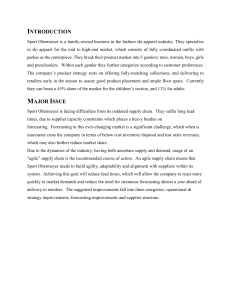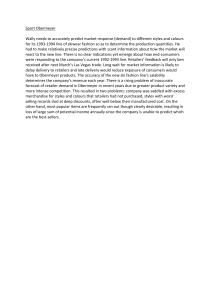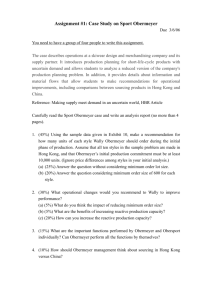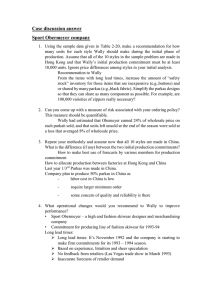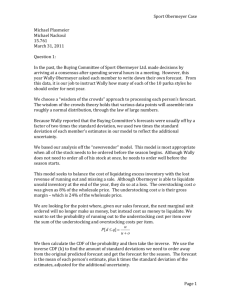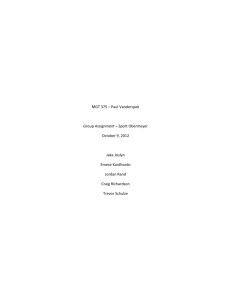Sport Obermeyer Case Study: Production & Forecasting
advertisement
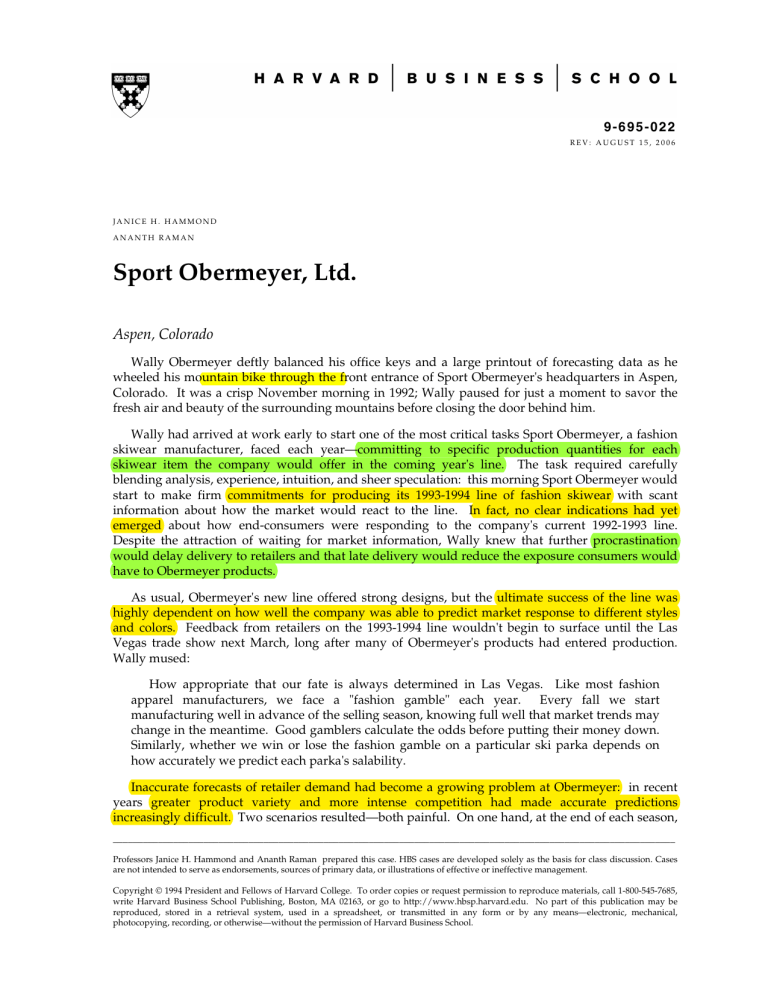
9-695-022 REV: AUGUST 15, 2006 JANICE H. HAMMOND ANANTH RAMAN Sport Obermeyer, Ltd. Aspen, Colorado Wally Obermeyer deftly balanced his office keys and a large printout of forecasting data as he wheeled his mountain bike through the front entrance of Sport Obermeyer's headquarters in Aspen, Colorado. It was a crisp November morning in 1992; Wally paused for just a moment to savor the fresh air and beauty of the surrounding mountains before closing the door behind him. Wally had arrived at work early to start one of the most critical tasks Sport Obermeyer, a fashion skiwear manufacturer, faced each year—committing to specific production quantities for each skiwear item the company would offer in the coming year's line. The task required carefully blending analysis, experience, intuition, and sheer speculation: this morning Sport Obermeyer would start to make firm commitments for producing its 1993-1994 line of fashion skiwear with scant information about how the market would react to the line. In fact, no clear indications had yet emerged about how end-consumers were responding to the company's current 1992-1993 line. Despite the attraction of waiting for market information, Wally knew that further procrastination would delay delivery to retailers and that late delivery would reduce the exposure consumers would have to Obermeyer products. As usual, Obermeyer's new line offered strong designs, but the ultimate success of the line was highly dependent on how well the company was able to predict market response to different styles and colors. Feedback from retailers on the 1993-1994 line wouldn't begin to surface until the Las Vegas trade show next March, long after many of Obermeyer's products had entered production. Wally mused: How appropriate that our fate is always determined in Las Vegas. Like most fashion apparel manufacturers, we face a "fashion gamble" each year. Every fall we start manufacturing well in advance of the selling season, knowing full well that market trends may change in the meantime. Good gamblers calculate the odds before putting their money down. Similarly, whether we win or lose the fashion gamble on a particular ski parka depends on how accurately we predict each parka's salability. Inaccurate forecasts of retailer demand had become a growing problem at Obermeyer: in recent years greater product variety and more intense competition had made accurate predictions increasingly difficult. Two scenarios resulted—both painful. On one hand, at the end of each season, ________________________________________________________________________________________________________________ Professors Janice H. Hammond and Ananth Raman prepared this case. HBS cases are developed solely as the basis for class discussion. Cases are not intended to serve as endorsements, sources of primary data, or illustrations of effective or ineffective management. Copyright © 1994 President and Fellows of Harvard College. To order copies or request permission to reproduce materials, call 1-800-545-7685, write Harvard Business School Publishing, Boston, MA 02163, or go to http://www.hbsp.harvard.edu. No part of this publication may be reproduced, stored in a retrieval system, used in a spreadsheet, or transmitted in any form or by any means—electronic, mechanical, photocopying, recording, or otherwise—without the permission of Harvard Business School. 695-022 Sport Obermeyer, Ltd. the company was saddled with excess merchandise for those styles and colors that retailers had not purchased; styles with the worst selling records were sold at deep discounts, often well below their manufactured cost. On the other hand, the company frequently ran out of its most popular items; although popular products were clearly desirable, considerable income was lost each year because of the company's inability to predict which products would become best-sellers. Wally sat down at his desk and reflected on the results of the day-long "Buying Committee" meeting he had organized the previous day. This year Wally had changed the company's usual practice of having the committee, which comprised six key Obermeyer managers, make production commitments based on the group's consensus. Instead, hoping to gather more complete information, he had asked each member independently to forecast retailer demand for each Obermeyer product. Now it was up to him to make use of the forecasts generated by the individuals in the group. He winced as he noted the discrepancies across different committee members' forecasts. How could he best use the results of yesterday's efforts to make appropriate production commitments for the coming year's line? A second issue Wally faced was how to allocate production between factories in Hong Kong and China. Last year, almost a third of Obermeyer's parkas had been made in China, all by independent subcontractors in Shenzhuen. This year, the company planned to produce half of its parkas in China, continuing production by subcontractors and starting production in a new plant in Lo Village, Guangdong. Labor costs in China were extremely low, yet Wally had some concerns about the quality and reliability of Chinese operations. He also knew that plants in China typically required larger minimum order quantities than those in Hong Kong and were subject to stringent quota restrictions by the U.S. government. How should he incorporate all of these differences into a wellfounded decision about where to source each product? Tsuen Wan, New Territories, Hong Kong Raymond Tse, managing director, Obersport Limited, was anxiously awaiting Sport Obermeyer's orders for the 1993-1994 line. Once the orders arrived, he would have to translate them quickly into requirements for specific components and then place appropriate component orders with vendors. Any delay would cause problems: increased pressure on his relationships with vendors, overtime at his or his subcontractors' factories, or even late delivery to Sport Obermeyer. Obersport Ltd. was a joint venture established in 1985 by Klaus Obermeyer and Raymond Tse to coordinate production of Sport Obermeyer products in the Far East (see Exhibit 1). Obersport was responsible for fabric and component sourcing for Sport Obermeyer's production. Materials sourced were cut and sewn either in Raymond Tse's own "Alpine" factories or in independent subcontractors located in Hong Kong, Macau, and China. Raymond was owner and president of Alpine Ltd., which included skiwear manufacturing plants in Hong Kong as well as a recently established facility in China. Sport Obermeyer's orders represented about 80% of Alpine's annual production volume. Lo Village, Guangdong, China Raymond Tse and his cousin, Shiu Chuen Tse, gazed with pride and delight at the recently completed factory complex. Located amongst a wide expanse of rice paddies at the perimeter of Lo Village, the facility would eventually provide jobs, housing, and recreational facilities for more than 300 workers. This facility was Alpine's first direct investment in manufacturing capacity in China. Shiu Chuen had lived in Lo village all of his life—the Tse family had resided there for generations. Raymond's parents, former landowners in the village, had moved to Hong Kong before Raymond 2 Sport Obermeyer, Ltd. 695-022 was born, returning to the village for several years when Raymond was a young boy during the Japanese occupation of Hong Kong in World War II. In 1991, Raymond Tse had visited Lo Village for the first time in over 40 years. The villagers were delighted to see him. In addition to their personal joy at seeing Raymond, they hoped to convince him to bring some of his wealth and managerial talent to Lo Village. After discussions with people in the community, Raymond decided to build the factory, so far investing over US$1 million in the facility. Working with Alpine's Hong Kong management, Shiu Chuen had hired 200 workers for the factory's first full year of operation. The workers had come from the local community as well as distant towns in neighboring provinces; most had now arrived and were in training in the plant. Shiu Chuen hoped he had planned appropriately for the orders Alpine's customers would assign to the plant this year; planning had been challenging since demand, worker skill levels, and productivity levels were all difficult to predict. Sport Obermeyer, Ltd. Sport Obermeyer's origins traced to 1947, when Klaus Obermeyer emigrated from Germany to the United States and started teaching at the Aspen Ski School. On frigid, snowy days Klaus found many of his students cold and miserable due to the impractical clothing they wore—garments both less protective and less stylish than the clothing skiers wore in his native Germany. During summer months, Klaus began to travel to Germany to find durable, high-performance ski clothing and equipment for his students. An engineer by training, Klaus also designed and introduced a variety of skiwear and ski equipment products; for example, he was credited with making the first goose-down vest out of an old down comforter in the 1950s. In the early 1980s, he popularized the "ski brake," a simple device replacing cumbersome "run-away straps"; the brake kept skis that had fallen off skiers from plunging down the slopes. Over the years, Sport Obermeyer developed into a preeminent competitor in the U.S. skiwear market: estimated sales in 1992 were $32.8 million. The company held a commanding 45% share of the children's skiwear market and 11% share of the adult skiwear market. Columbia Sportswear was a lower-price, high-volume-per-style competitor whose sales had increased rapidly during the previous three years. By 1992 Columbia had captured about 23% of the adult ski-jacket market. Obermeyer offered a broad line of fashion ski apparel, including parkas, vests, ski suits, shells, ski pants, sweaters, turtlenecks, and accessories (see examples in Exhibit 2). Parkas were considered the most critical design component of a collection; the other garments were fashioned to match the parkas' style and color. Obermeyer products were offered in five different "genders": men's, women's, boys', girls', and preschoolers'. The company segmented each "gender" market according to price, type of skier, and how "fashion-forward" the market was. For example, the company divided its adult male customers into four types, dubbed Fred, Rex, Biege, and Klausie. A "Fred" was the most conservative of the four types; Freds had a tendency to buy basic styles and colors and were likely to wear the same outfit over multiple seasons. "High-tech" Rex was an affluent, image-conscious skier who liked to sport the latest technologies in fabrics, features, and ski equipment. In contrast, "Biege" was a hard-core mountaineering-type skier who placed technical performance above all else and shunned any nonfunctional design elements. A "Klausie" was a flamboyant, high-profile skier or snowboarder who wore the latest styles, often in bright colors such as neon pink or lime green. Within each "gender," numerous styles were offered, each in several colors and a range of sizes. Exhibit 3 shows how the variety of Obermeyer's women's parkas had changed over time, including 3 695-022 Sport Obermeyer, Ltd. the total number of stock-keeping units (SKUs) Obermeyer offered during the preceding 16-year period, as well as the average number of styles, colors per style, and sizes per style-color combination offered. Obermeyer competed by offering an excellent price/value relationship, where value was defined as both functionality and style, and targeted the middle to high end of the skiwear market. Unlike some of its competitors who made outerwear for both skiing and for casual "street wear," Obermeyer sold the vast majority (over 85%) of its products to customers for use while skiing. Functionality was critical to the serious skier—products had to be warm and water-proof, yet not constrain the skier's ability to move his or her arms and legs freely. Management believed that the effective implementation of its product strategy relied on several logistics-related activities, including delivering matching collections of products to retailers at the same time (to allow consumers to view and purchase coordinated items at the same time), and delivering products to retail stores early in the selling season (to maximize the number of "squarefootage days" products were available at retail). Management Approach Throughout the company's history, Klaus Obermeyer had been actively involved in company management. Klaus believed that a company should run "free of tension." Klaus's personal philosophy was at the core of his management style; in both his personal life and his professional life he sought to "achieve harmony." He observed: We're blending with the forces of the market rather than opposing them. This leads to conflict resolution. If you oppose a force, you get conflict escalation. It is not money, it is not possessions, it is not market share. It is to be at peace with your surroundings. In accordance with his philosophy, Klaus believed that the skiwear industry should be left to people who were "comfortable with an uncertain bottom line." Klaus's management style emphasized trust in people and providing value to customers. He believed many aspects of the business fell into the artistic realm; in making decisions, one should be guided by one's judgment and intuition. In his joint venture with Raymond Tse, Klaus relied on his trust of Raymond and had always left production and investment decisions to Raymond. Although Klaus was the "heart and soul" of the company, other members of the family had played key roles in the company's growth as well. Klaus's wife, Nome, a successful designer, was actively involved in developing new products for the company. In Klaus's judgment, Nome had a "feel" for fashion—Klaus had relied heavily on her judgment in assessing the relative popularity of various designs. In recent years, Klaus's son Wally had become actively involved in managing the company's internal operations. After completing high school, Wally combined working part-time for the company with ski-patrolling on Aspen Mountain for six years before entering college in 1980. After graduating from the Harvard Business School in 1986, Wally initially focused his efforts on developing a hydro-electric power-generating plant in Colorado. By 1989, when the power plant was established and required less day-to-day involvement, Wally joined Sport Obermeyer full time as vice president. As is often the case, the company founder and his MBA son had different management approaches; Wally relied more heavily on formal data gathering and analytical techniques, whereas Klaus took a more intuitive style that was heavily informed by his extensive industry experience. 4 Sport Obermeyer, Ltd. 695-022 The Order Cycle Sport Obermeyer sold its products primarily through specialty ski-retail stores, located either in urban areas or near ski resorts. Obermeyer also served a few large department stores (including Nordstrom) and direct mail retailers (including REI). In the U.S., most retail sales of skiwear occurred between September and January, with peak sales occurring in December and January. Most retailers requested full delivery of their orders prior to the start of the retail season; Sport Obermeyer attempted to deliver coordinated collections of its merchandise into retail stores by early September. Nearly two years of planning and production activity took place prior to the actual sale of products to consumers (see Exhibit 4). The Design Process xem phụ lục 4 cho nhanh tháng 2 The design process for the 1993-1994 line began in February 1992, when Obermeyer's design team and senior management attended the annual international outdoorswear show in Munich, Germany, to view current European offerings. "Europe is more fashion-forward than the U.S.," Klaus noted. "Current European styles are often good indicators of future American fashions." In addition, each year, a major trade show for ski equipment and apparel was held in Las Vegas. The March 1992 Las Vegas show had provided additional input to the design process for the 1993-1994 line. By May 1992, the design concepts were finalized; sketches were sent to Obersport for prototype production in July. Prototypes were usually made from leftover fabric from the previous year since the prototype garments were used only internally by Obermeyer management for decision-making purposes. Obermeyer refined the designs based on the prototypes and finalized designs by September 1992. Sample Production As soon as designs were finalized, Obersport began production of sample garments—small quantities of each style-color combination for the sales force to show to retailers. In contrast to prototypes, samples were made with the actual fabric to be used for final production; dyeing and printing subcontractors were willing to process small material batches for sample-making purposes. Sales representatives started to show samples to retailers during the week-long Las Vegas show, typically held in March, and then took them to retail sites throughout the rest of the spring. Raw Material Sourcing and Production Concurrent with sample production, Obersport determined fabric and component requirements for Obermeyer's initial production order (typically about half of Obermeyer's annual production) based on Obermeyer's bills of material. It was important that Obersport place dyeing/printing instructions and component orders quickly since some suppliers' lead times were as long as 90 days. Cutting and sewing of Obermeyer's first production order would begin in February 1993. Retailer Ordering Process During the Las Vegas trade show, most retailers placed their orders; Obermeyer usually received orders representing 80% of its annual volume by the week following the Las Vegas show. With this information in hand, Obermeyer could forecast its total demand with great accuracy (see Exhibit 5). After completing its forecast, Obermeyer placed its second and final production order. The remainder of retailers' regular (non-replenishment) orders were received in April and May. As noted 5 695-022 Sport Obermeyer, Ltd. below, retailers also placed replenishment orders for popular items during the peak retail sales season. Shipment to Obermeyer Warehouse During June and July, Obermeyer garments were transported by ship from Obersport's Hong Kong warehouse to Seattle, from which they were trucked to Obermeyer's Denver distribution center. (Total shipment time was approximately six weeks.) Most goods produced in August were airshipped to Denver to ensure timely delivery to retailers. In addition, for goods manufactured in China, air freighting was often essential due to strict quota restrictions in certain product categories. The U.S. government limited the number of units that could be imported from China into the United States. Government officials at the U.S. port of entry reviewed imports; products violating quota restrictions were sent back to the country of origin. Since quota restrictions were imposed on the total amount of a product category all companies imported from China, individual companies often rushed to get their products into the country before other firms had "used up" the available quota. đơn bán lẻ bổ sung Shipment to Retail; Retail Replenishment Orders Toward the end of August, Obermeyer shipped orders to retailers via small-package carriers such as UPS. Retail sales built gradually during September, October, and November, peaking in December and January. By December or January, retailers who identified items of which they expected to sell more than they currently had in stock often requested replenishment of those items from Obermeyer. This demand was filled if Obermeyer had the item in stock. By February Obermeyer started to offer replenishment items to retailers at a discount. Similarly, retailers started marking down prices on remaining stock in an attempt to clear their shelves by the end of the season. As the season progressed, retailers offered deeper discounts; items remaining at the end of the season were held over to the following year and sold at a loss. Obermeyer used a variety of methods to liquidate inventory at year-end, including selling large shipping containers of garments well below manufacturing cost to markets in South America and engaging in barter trade (for example, trading parkas in lieu of money for products or services used by the company, such as hotel rooms or air flights). The Supply Chain cung cấp dệt may & phụ kiện Textile and Accessories Suppliers Apparel Manufacturers Obersport Sport Obermeyer Retailers Obermeyer sourced most of its outerwear products through Obersport. In recent years, Wally had worked with Obersport to "pre-position" (purchase prior to the season and hold in inventory) greige fabric1 as part of a wider effort to cope with manufacturing lead times. To pre-position the fabric, Obermeyer would contract with fabric suppliers to manufacture a specified amount of fabric of a given type each month; Obermeyer would later specify how it wanted the fabric to be dyed and/or printed. Obermeyer had to take possession of all fabric it contracted for, whether or not it was 1Greige fabric is fabric that has been woven or knitted but not yet dyed or printed. 6 Sport Obermeyer, Ltd. 695-022 actually needed. Different types of fabrics were purchased for use as shell (outer) fabric and lining fabric. Approximately 10 types of shell fabrics were required each year. Obersport purchased shell fabric from vendors in the United States, Japan, Korea, Germany, Austria, Taiwan, and Switzerland. Lining fabric was sourced primarily from Korea and Taiwan. (Exhibit 6 provides information on lead times, variety, and other aspects of component sourcing.) Each greige fabric would later be dyed and/or printed as necessary; each shell fabric was typically offered in 8 to 12 colors and prints. Prior to the start of the season, Obersport would work with its subcontractors to prepare a small batch for each color that was required in a given fabric. The preparation of each such "lab-dip" took two weeks; the procedure at times had to be repeated if the quality of the lab-dip was not found to be satisfactory by Obermeyer managers or designers. In addition, Obersport worked with its printing subcontractors to develop "screens" which would be used to print patterns on fabric. This procedure took six weeks. Most other tasks were performed only after the production quantities planned by Sport Obermeyer were known. Immediately after receiving production instructions from Sport Obermeyer, Obersport asked subcontractors to dye or print fabric. A typical adult's parka, for example, required 2.25 to 2.5 yards of 60" width shell fabric. The consumption of fabric was slightly less for kids' or preschoolers' parkas. Dyeing subcontractors required a lead time of 45-60 days and a minimum order quantity of 1,000 yards. Printing subcontractors required a minimum of 3,000 yards; printing lead times were also 45-60 days. Obermeyer products used insulation materials and a variety of other components in addition to shell and lining fabric. Each parka, for example, needed around 2 yards of insulation material. Insulation materials (with the exception of goose-down insulation, which was purchased in China and Korea) were purchased from DuPont, whose licensees in Hong Kong, Taiwan, Korea and China could provide them within two weeks. At the beginning of each year, Obersport gave DuPont an estimate of its annual requirement for each type of insulation. Obersport also had to ensure the availability of a variety of other components such as D-rings, buckles, snaps, buttons, zippers, pull-strings with attached castings, and various labels and tags. Buckles, D-rings, pull-strings and buttons were procured locally in Hong Kong and had a 15- to 30day lead time. Many snaps were purchased from German vendors; since snap lead times were long, Obersport kept an inventory of snaps and dyed them locally as needed. Labels and tags had short lead times and were relatively inexpensive; Obersport generally carried excess stock of these materials. Most zippers were purchased from YKK, a large Japanese zipper manufacturer. Obersport used a wide variety of zipper types each year. Zippers varied by length, tape color, and slider shape as well as the gauge, color, and material of the zipper teeth. Approximately 60% of Obersport's zipper requirements were sourced from YKK's Hong Kong factory, where standard zippers were manufactured. The lead time for these zippers was 60 days. The remainder were non-standard zippers, which were sourced from Japan with at least 90-day lead times—sometimes longer. YKK required a minimum order quantity of 500 yards if the dyeing color was a standard color from its catalog; if not, the minimum order quantity was 1,000 yards. All production materials were received by Obersport; materials for any given style were then collected and dispatched to the factory where the particular style was to be cut and sewn. Obermeyer products were produced in a number of different factories in Hong Kong and China. 7 695-022 Sport Obermeyer, Ltd. Cut and Sew A typical Obermeyer product required many cutting and sewing steps. (Exhibit 7 shows the sequence of sewing operations for the Rococo parka.) The allocation of operations to workers differed from one factory to another depending on the workers' level of skill and the degree of worker cross-training. Workers in Hong Kong worked about 50% faster than their Chinese counterparts. In addition to being more highly skilled, Hong Kong workers were typically trained in a broader range of tasks. Thus, a parka line in Hong Kong that required 10 workers to complete all operations might require 40 workers in China. Longer production lines in China led to greater imbalance in these lines; hence, a Hong Kong sewer's actual output during a given period of time was nearly twice that of a Chinese worker. (See Exhibit 8 for a comparison of Hong Kong and China operations. The cost components of the Rococo parka, which was produced in Hong Kong, are shown in Exhibit 9A. Exhibit 9B shows the estimated cost of producing the Rococo in China. Obermeyer sold the Rococo parka to retailers at a wholesale price of $112.50; retailers then priced the parka at $225.) Workers were paid on a piece-rate basis in both China and Hong Kong: the piece rate was calculated to be consistent with competitive wage rates in the respective communities. Wages in China were much lower than in Hong Kong; an average sewer in a Guangdong sewing factory earned US$0.16 per hour compared with US$3.84 per hour in the Alpine factory in Hong Kong. Workers in Hong Kong were also able to ramp up production faster than the Chinese workers. This ability, coupled with shorter production lines, enabled the Hong Kong factory to produce smaller order quantities efficiently. For parkas, the minimum production quantity for a style was 1,200 units in China and 600 units in Hong Kong. Obermeyer produced about 200,000 parkas each year. The maximum capacity available to the company for cutting and sewing was 30,000 units a month; this included the production capacity at all factories available to make Sport Obermeyer products. Obersport was responsible for monitoring production and quality at all subcontractor factories. Workers from Obersport inspected randomly selected pieces from each subcontractor's production before the units were shipped to the United States. Production Planning Wally's immediate concern was to determine an appropriate production commitment for the first half of Obermeyer's projected demand for the 1993-1994 season. He had estimated that Obermeyer earned 24% of wholesale price (pre-tax) on each parka it sold, and that units left unsold at the end of the season were sold at a loss that averaged 8% of wholesale price. Thus, for example, on a parka style such as the Rococo, which had a wholesale selling price of $112.50, Obermeyer's expected profit on each parka sold was approximately 24%($112.50) = $27, and its expected loss on each parka left unsold was approximately 8%($112.50) = $9. A Sample Problem To build his intuition about how to make production decisions, he decided to look at a smaller version of the company's problem. He looked at the Buying Committee's forecasts for the sample of 8 Sport Obermeyer, Ltd. 695-022 10 women's parkas2 (see Exhibit 10). Since these 10 styles represented about 10% of Obermeyer's total demand, to make this smaller version representative of the larger problem, he assumed he had cutting and sewing capacity of 3,000 units per month (10% of actual capacity) during the sevenmonth production period. Using these assumptions, Wally needed to commit 10,000 units for the first phase of production. The remaining 10,000 units could be deferred until after the Las Vegas show. Wally studied the Buying Committee's forecasts, wondering how he could estimate the risk associated with early production of each style. Was there some way he could use the differences among each member's forecast as a measure of demand uncertainty? An examination of demand from previous years indicated that forecast accuracy was the highest for those styles the Buying Committee had the highest level of agreement. (Technically, he found that the standard deviation of demand for a style was approximately twice the standard deviation of the Buying Committee's forecasts for that style.) With this in mind, he constructed a forecast distribution for each style as a normal random variable with the mean equal to the average of the Buying Committee member's forecasts and standard deviation twice that of the Buying Committee's forecasts (see Exhibit 11). Where to Produce To complete the planning decision, Wally would also need to decide which styles to make in Hong Kong and which would be better to produce in China. This year, Obermeyer expected to produce about half of all its products in China. Longer term, Wally wondered whether producing in China would constrain Obermeyer's ability to manage production and inventory risks. Would China's larger minimum order sizes limit the company's ability to increase the range of products it offered or to manage inventory risk? Was Obermeyer's trend toward increased production in China too risky given the uncertainty in China's trade relationship with the United States? 2When the Buying Committee convened, Wally had asked each member to forecast sales so that each member's total forecast summed to a specified aggregate figure (for parkas, 200,000 units). Similarly, the forecasts in the sample problem have been scaled to sum to 20,000 units. 9 695-022 Exhibit 1 Map of Facilities (Hong Kong and Guangdong) 10 Sport Obermeyer, Ltd. Sport Obermeyer, Ltd. Exhibit 2 695-022 Sample Obermeyer Products 11 695-022 Sport Obermeyer, Ltd. Exhibit 3 Product Variety, Obermeyer Women's Parkas 800 700 Total Number of SKUs 600 500 400 300 200 93/94 92/93 91/92 90/91 89/90 88/89 87/88 86/87 85/86 84/85 83/84 82/83 81/82 80/81 79/80 0 78/79 100 25 Number of Styles 20 15 10 5 88/89 89/90 88/89 89/90 93/94 87/88 87/88 92/93 86/87 86/87 91/92 85/86 85/86 90/91 84/85 83/84 82/83 84/85 9 81/82 80/81 79/80 78/79 0 Average Number of Colors per Style 8 7 6 5 4 3 2 Average Number of Sizes per Style-Color Combination 1 Note: An example of a "style" is a Stardust parka. An example of a "style-color combination" is a red Stardust parka. An example of a "SKU" (stock-keeping unit) is a size 8, petite, red Stardust parka. 12 93/94 92/93 91/92 90/91 83/84 82/83 81/82 80/81 79/80 78/79 0 Sport Obermeyer, Ltd. 695-022 Exhibit 4 Planning and Production Cycle, Obermeyer 1993-1994 Line Month Feb 92 Mar 92 May 92 Jul 92 Aug 92 Sep 92 Oct 92 Nov 92 Design Activities Order Receipt and Production Planning Design process begins Las Vegas show for 92-93 line Concepts finalized Sketches sent to Obersport Materials Management Apr 93 May 93 Jun 93 Prototype production Prototype production Designs finalized Place first production order with Obersport Receive first order • Calculate fabric and component requirements • Order components • Place print/dye orders Las Vegas Show for 93-94 line (80% of retailers' initial orders received) Place second production order with Obersport Additional retailer orders received Additional retailer orders received Additional retailer orders received Aug 93 Jan 94 Feb 94 Mar 94 Apr 94 Sample production Sample production Sample production Chinese New Year vac. Jul 93 Sep 93 Oct 93 Nov 93 Dec 93 Retail Activities Order greige fabric Dec 92 Jan 93 Feb 93 Mar 93 Production Retailer replenishment orders received Retailer replenishment orders received Retailer replenishment orders received Receive second order • Calculate fabric and component requirements • Order components • Place print/dye orders Chinese New Year vac. Full-scale production Full-scale production Full-scale production Full-scale production Full-scale production Ship finished goods Full-scale production Ship finished goods Full-scale production Air freight finished goods 93-94 line delivered to retail Retail selling period Retail selling period Retail selling period Peak retail selling period Peak retail selling period Retail selling period Retail selling period Retail selling period 13 695-022 Sport Obermeyer, Ltd. Exhibit 5 How Demand Forecasts Improve with Increasing Information Initial Forecast 3,500 3,000 Each data point represents the forecast and actual season sales for a particular parka (at the stylecolor level). For example, parka A had an initial forecast of 2,500 units and season sales of 510 units. 2,500 2,000 1,500 1,000 4,000 3,500 2,000 1,500 1,000 500 0 0 3,000 A 500 2,500 Total Sales of Women's Parkas 4,000 Updated Forecast, Incorporating First 20% of Sales Data 3,500 3,000 2,500 After observing 20% of demand, the revised forecast for parka A was 575 units. 2,000 1,500 1,000 4,000 3,500 3,000 2,500 1,000 500 0 0 2,000 A 500 1,500 Total Sales of Women's Parkas 4,000 Final Forecast, Incorporating First 80% of Sales Data 3,500 3,000 2,500 After observing 80% of demand, the final forecast for parka A was 500 units. 2,000 1,500 1,000 14 4,000 3,500 3,000 2,500 2,000 500 0 0 1,500 A 500 1,000 Total Sales of Women's Parkas 4,000 6 3-4 different weights used (from 80-240 grams/meter) 400 standard tape colors 4 teeth gauges 4-5 teeth colors 2-3 teeth materials 5-6 slider types 80 colors various 10 50 colors Finished Lining Fabric Insulation Zippers Thread Logo Patches, Drawcords, Hang Tags, etc. Snaps (undyed) Dyeing of Snaps Source: Obersport 8-12 color-prints per fabric Finishing of Shell Fabric Variety 10 Greige Shell Fabric Component Country of Origin Hong Kong Germany, Italy, Hong Kong Mostly from Hong Kong Hong Kong Hong Kong, Japan Hong Kong, Korea, Taiwan, China Nylon: Korea, Taiwan Fleece: Korea, Taiwan, USA Finishing takes place in country of origin (see above) Japan, USA, Switzerland, Germany, Austria, Korea, Taiwan 15-30 days 1-2 months 15-30 days 30 days Standard (from Hong Kong): 60 days Custom (from Japan): 90+ days 2-3 weeks 45-60 days Dyeing or Printing: 45-60 days 45-90 days Procurement Lead Time Exhibit 6 Procurement Information for Obermeyer's Parka Components Minimums 1000 pieces per color 1,000 pieces various 5,000 yards 500 yards (standard colors) 1000 yards (custom colors) 50-100 yards 600-1,000 yards Dyeing: 1,000 yards Printing: 3,000 yards per design, at least 1,000 yards per color in any design 5,000-10,000 yards Usage per Parka 5-10 pieces 5-10 pieces various 2,000-3,000 yards ~ 1 yard ~ 2 yards per adult parka ~ 1.2-1.5 yards per child's parka 2-2.25 yards per adult parka 1.25-1.75 yards per child's parka 2.25-2.5 yards per adult parka 1.5-2 yards per child's parka 2 .2-2.5 yards per adult parka 1.5-2 yards per child's parka 100% 1% 3% 10% 2% 12% 16% 13% 13% 30% Avg. % of Total Parka Material Cost 695-022 -15- 695-022 Sport Obermeyer, Ltd. Exhibit 7 Sample—Parka Assembly Operations for the Rococo Women's Parka Operation HK$/ Piece $0.05 Make belt loop (× 1). (Subcomponent completed by outside subcontractor) $0.20 Sew front shoulder seam with invisible stitching. Quilt all over: lining (× 5), front placket (× 1), and collar (× 2). (Subcomponent completed by outside subcontractor) 3 $0.50 Invisible-stitch front bellow facing (× 2). 4 $0.50 Double top-stitch front bellow facing (× 2). 5 $0.70 Zig-zag stitch front bellow seam (× 2). 6 $2.40 Set double-jetted zipped pocket (× 2) and insert D-ring (× 1). 7 $0.25 Five-stitch overlock pocket bag (× 2). 8 $1.00 Invisible-stitch bottom bellow facing, sew front shoulder pleat (× 2), insert front body facing. 9 $0.40 1/4” double stitch the front and back shoulder seam (× 4). 10 $0.30 Single top stitch (the middle of double top-stitching) the front and back shoulder seam (× 4). 11 $4.50 Turn over the body and attach collar, sew zipper; invisible-stitch bottom and sleeve opening, leave a small opening at the bottom of left front zipper. 12 $1.00 1/4” double stitch the front zipper seam from bottom to collar top. 13 $0.50 Invisible stitch the back bellow seam (× 2). 14 $0.50 1/4” double stitch the back bellow seam. 15 $0.70 Zig-zag stitch back bellow seam (× 2). 16 $1.00 Join under facing of back bellow seam with invisible stitching (× 2). Join front and back shoulder seam with invisible stitching (× 4). 17 $0.50 Close side seam with invisible stitching, match seam ends (× 6). 18 $0.25 Three-stitch overlock the side seam. 19 $1.00 Sew sleeve opening, bottom hem with invisible stitching. 20 $0.80 Invisible stitch front placket seam, then 1/4” double top-stitch the placket seam. 21 $1.10 Invisible stitch the sleeve seam (x 4); invisible stitch sleeve panel seam, sew pleats at sleeve panel seam (× 2). 22 $0.90 1/4” double top-stitch raglan sleeve seam and sleeve panel seam (× 6). 23 $0.70 Single lockstitch raglan sleeve seam and sleeve panel seam, double stitch the center of sleeve panel seam (× 6). 24 $0.70 Invisible stitch the armhole seam (× 2), match the notch of armhole seam (× 2). 25 $0.50 Double stitch armhole seam (× 2). 26 $0.40 Single lockstitch raglan sleeve seam and sleeve panel seam, double stitch the center of sleeve panel seam (× 6) 27 $0.60 Single lockstitch to close bottom hem facing (× 1), insert the drawstring to bottom hem. 28 $0.60 Invisible stitch sleeve opening, insert/sew elastic to sleeve opening (× 2). 29 $1.00 Sew collar facing (× 1), invisible stitch the collar top, close bottom of collar, insert belt loop, change thread. 30 $0.25 1/4” double needle stitch at middle part of placket (× 1). 31 $0.35 Zig-zag stitch at the center of double needle stitch at placket (× 1). 32 $0.80 Running stitch to close the end of filled placket (× 1). 33 $0.20 Sew main label, and insert the label at side seam, and then sew size label. 34 $0.80 Sew the inside pocket: pocket with zipper at left, pocket with velcro at right. 35 $0.20 Set front facing with 1/16” edge stitching (× 2). 36 $1.70 3 stitch overlock lining pocket bag (× 2). 37 $1.60 Sew triangular stitching at ends of zipper facing, invisible stitch at zipper facing seam, turn out and 1/16” edge-stitching (× 1). 38 $1.30 Sew 13 top stitching at the lining body. 39 $1.40 Five stitch overlock the lining body. 40 $0.80 Set shoulder pad (× 2). Note: Total Average Labor Cost for the Rococo parka = $HK78. Column does not add since some operations were performed multiple times to completely assemble one parka. 1 2 16 Sport Obermeyer, Ltd. 695-022 Exhibit 8 Comparison of Operations in Hong Kong and China Topic Hong Kong China Hourly Wage HK$30 RMB 0.91 Exchange Rate HK$7.8 = US$1 RMB (Renminbi) 5.7 = US$1 Working Hours 8 hours/day, 6 days/week 9 hours/day, 6.5 days/week => Total = 48 hours/week => Total = 58.5 hours/week Maximum overtime allowed = 200 hours/year During peak production periods, workers work 13 hours/day, 6.5 days/week Weekly (Nonpeak) Output/Worker 19 parkas 12 parkas Actual labor content per parka (including repair work) ~2.35 hours ~3.6 hours Paid labor time per parka (including repair work) ~2.53 hours/parka ~4.88 hours/parka Labor Cost/Garment HK$75.6 RMB4.45 Line Configuration 10-12 people/line 40 people/line Training Cross-trained Trained for single operation only Minimum Order Quantity 600 units in same style 1,200 units in same style Repair Rate 1-2% ~10% Challenges • Wage Rate • Workforce: • Low unemployment (~2%) • Younger workers prefer office jobs • Workforce: • Less quality and cleanliness conscious • Training requirements 17 695-022 Sport Obermeyer, Ltd. Exhibit 9A Cost Information for Rococo Parka (Made in Hong Kong) Obermeyer Landed Cost Cost FOB Obersporta Agent's Fee (to Obersport, 7%) Freight (Ocean Carrier)b Duty, Insurance, and Miscellaneous $49.90 $3.49 $1.40 $5.29 Total Landed Cost $60.08 Cost FOB Obersport: Material $30.00 Labor $10.00 Hong Kong Quota, Obersport Profit and Overhead $ 9.90 Total $49.90 All figures in US Dollars Exhibit 9B Estimated Cost Information for Rococo Parka (if assembled in China) Obermeyer Landed Cost Cost FOB Obersporta $42.64 Agent's Fee (to Obersport, 7%) $2.98 Freight (Ocean Carrier)b $1.40 Duty, Insurance, and Miscellaneous $4.90 Total Landed Cost $51.92 Cost FOB Obersport: Material $30.00 Labor $0.78 Transportation within China and China Overhead $2.00 China Quota, Obersport Profit and Overhead $9.90 Total $42.68 All figures in US Dollars a FOB (free on board) Obersport means Obermeyer paid for freight and owned products while they were in transit. bIf 18 transportation by air, cost would be approximately $5.00 per parka. Sport Obermeyer, Ltd. 695-022 Exhibit 10 Sample Buying Committee Forecasts, 10 Styles of Women's Parkas Individual Forecasts Average Forecast Standard Deviation 2 x Std. Deviation Pricea Laura Carolyn Gail $110 900 1,000 900 1,300 800 1,200 1,017 194 388 Isis $99 800 700 1,000 1,600 950 1,200 1,042 323 646 Entice $80 1,200 1,600 1,500 1,550 950 1,350 1,358 248 496 Assault $90 2,500 1,900 2,700 2,450 2,800 2,800 2,525 340 680 Teri $123 800 900 1,000 1,100 950 1,850 1,100 381 762 Electra $173 2,500 1,900 1,900 2,800 1,800 2,000 2,150 404 807 Stephanie $133 600 900 1,000 1,100 950 2,125 1,113 524 1,048 Seduced $73 4,600 4,300 3,900 4,000 4,300 3,000 4,017 556 1,113 Anita $93 4,400 3,300 3,500 1,500 4,200 2,875 3,296 1,047 2,094 $148 1,700 3,500 2,600 2,600 2,300 1,600 2,383 697 1,394 20,000 20,000 20,000 20,000 20,000 20,000 20,000 Style Daphne Totals aObermeyer's Greg Wendy Tom Wally wholesale price Notes Laura Kornashiewicz was marketing director Carolyn Gray was customer service manager Greg Hunter was production manager Wendy Hemphill was production coordinator Tom Tweed was a sales representative Wally Obermeyer was vice president Exhibit 11 Forecast Distribution for the Electra Parka (Forecast parameters from Exhibit 10) standard deviation = 807 mean = 2,150 19
